Translation:Dictionary of French Architecture from the 11th to 16th Century/Volume 1/Astragal
ASTRAGAL
editMoulding which separates the capital from the barrel of the column. In the Roman orders, the astragal forms part of the barrel; it is made up

of a cavet, a net and a torus (1). This form is generally followed in the buildings of the beginning of the Middle Ages. The barrel of the column carries the astragale; but, starting from the 12th century, one often sees the astragale holding with the capital, in order to avoid the considerable cavity that its release obliges to make on the barrel. As long as the column is decreased or bent, this cavity is not made that in a part of the barrel; but when the column becomes a perfect cylinder, i.e. when its diameter is equal bottom in top, from the first years of the 13th century, the astragale becomes, without exception, a member of the capital. Its profile varies 10th to the 16th century, like form and dimension. In the buildings of the time carlovingienne, the astragal takes, relative with the height of the capital and the diameter of the column, a greatter importance than in the Roman orders; the cavet is reduced with depends on the torus, or disappears completely (2) 1, or is replaced by an ornament.

The form of the Roman astragal forming part of the barrel of the column is especially preserved in the regions where the ancient monuments remained upright. At Autun, at Langres, in Burgundy, Provence, in Auvergne, the astragal preserves usually its primitive members to the 13th century; only, during the 12th century, they become finer, and the cavet, instead of marrying with the barrel, is separated by from it a light projection (3) 2. Sometimes, at that time of research in the execution of the profiles, the torus of the astragal, instead of presenting out of cut a half-circle, is flattened (4) 3, or is composed of fine mouldings, or is cut according to a polygon (5) 4. As the sculpture of the capitals becomes more elegant and refouillée, that the diameters of the columns become less


forts, the astragals lose of their primitive heaviness and are detached well really barrel. Here (6) a astragal of the one of the capitals of the chorus of the church of Vezelay (first years of the 13th century); (7) of the capitals of the gallery of the kings of Our-injury of Paris (even time). Then finally we give (8) the profile of the astragal adopted almost without exception during the 13th century; profile which, in accordance with the method then used, is used as drip with the column.
Sometimes in the buildings of transition, the astragal is decorated; in the chorus of the cathedral of Paris, some capitals of the triforium are provided with astragals composed of lines of small water sheets (9); later still one finds, especially in Normandy, of the decorated astragals, as one can notice it in the chorus of the cathedral of Mans (10).

During the 14th century, the astragals are thinned down, their profiles become less accentuated (11). To the 15th century, they take contrary to heaviness and of the dryness, like all the profiles of this time; they have a strong projection which contrasts with the excessive thinness of the posts or vertical prisms (12). It is not necessary to add that at the time of the rebirth the Roman astragal reappears with the imitations of the orders of antiquity.


1 : A, de la crypte de l'église Saint-Léger à Soissons; B, de la crypte de l'église de Saint-Denis en France; C, de la nef de l'église Saint-Menou (Bourbonnais).
2 : Cathédrale de Langres.
3 : Clocher vieux de la cathédrale de Chartres.
4 : Salle capitulaire de Vézelay, A; église de Montréal, B (Bourgogne).